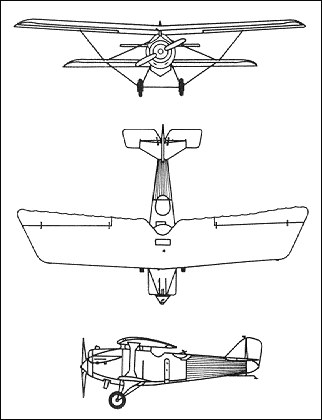 |
Breguet 191924 |  |
| RECON, BOMBER | Virtual Aircraft Museum / France / Breguet |
 |
The first prototype Bre 19.01 was displayed at the Salon Aeronautique in 1921 while fitted with a 335.3kW Breguet-Bugatti engine. However, for the first flight in March 1922, a similarly rated Renault 12Kb was installed. In 1923 the prototype won a Spanish international military aircraft contest and the 11 pre-production machines under construction in France were inspected by a Yugoslav delegation. Sales to both countries followed. The Bre 19 was mostly of metal construction, with fabric covering only the unequal-span wings, aft fuselage and tailplane. Large-scale production of A2 (observation) and B2 (day bomber) versions, powered by Renault 12K or Lorraine 12 engines, was undertaken; 'Amenagement 1926' machines having increased fuel capacity. More than 1,000 were built for French service, the type equipping many Groupes of the French Aeronautique Militaire from 1925; the last escadrilles did not relinquish their aircraft until 1935. Included in the total were a number of night fighter (Cn2) variants. Foreign deliveries went to Poland (250), Yugoslavia (160, plus 190 built under licence at Kraljevo), Romania (108), China (74), Greece (30), Argentina (25), Turkey (20), Spain (19, plus 177 built under licence by CASA), Venezuela (12), Bolivia (15), Belgium (6, plus 146 built under licence by SABCA) and Brazil (5). One hundred and three Yugoslav Bre 19 were still in service in 1939, many powered by 313kW Gnome Rhone Jupiter radial engines. Bre 19 were also used extensively during the Spanish Civil War by both sides, but combat losses and lack of spares led to their disappearance from the scene. Many record flights were made by Breguet 19 including one made by the 'Grand Raid' version named Nungesser-Coli, which was flown from Paris to San Francisco and Tokyo to Paris by Costes and Le Brix, covering 57,000km in 350 hours flying time. The pilots are best remembered for making the first non-stop air crossing of the South Atlantic, from Senegal to Natal, Brazil, on 14 October 1927. Also, in September 1929 a Breguet 19 'Super Bidon' named Point d'Interrogation was flown by Costes and Bellonte from Le Bourget to Manchuria to set up a new world distance record of 7,905km. A year later it was the first aircraft to fly non-stop from Paris to New York. In 1928 the Breguet 19ter was developed into the improved Breguet 19.7, with a 484.3kW Hispano-Suiza 12Nb engine, new wings with semi-elliptical tips, redesigned vertical tail-plane and increased fuel tankage. Yugoslavia built 75 and a small batch built by Breguet went to Romania. Fifty similar aircraft were exported to Turkey in 1932 and were the last of the breed to be built by Breguet. Forty-eight Yugoslav-built Breguet 19.8 had Wright Cyclone 580kW radials with long chord cowlings, the last being completed in 1937. Yugoslav Breguets were used later by Croat forces, and two recaptured by Tito's troops were flown during 1945.

|  COMPANY PROFILE | ||||||||||||||||||||||||||||||||||||||||||||||||||||||
 |

|

